|
|

This chapter explains how to set up and modify the configuration of the Catalyst 3000 using a directly-attached console.
In this chapter covers the following topics:
To work within the console menus, follow these guidelines:
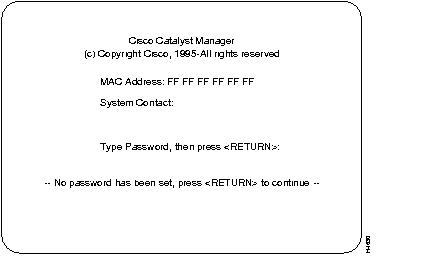
Use the "ARROW" keys (also referred to as cursor keys) to move the highlight over a selection. If the selection is a menu, pressing the RETURN key displays a new screen of information; if the selection is a command, such as "Reset", pressing the RETURN key initiates that function.
A heading with three "dots" after it means that when that heading is selected more information about that heading is displayed.
Unless specified differently, all the screens or menus are accessed in the same way.
The following lists the headings for the Main menu screen and a description of those headings.

Displays the Configuration menu, which enables you to view and set the Catalyst 3000 configuration parameters. The Configuration section and its sub-menus are described later in this chapter.
Displays Statistics menu for the Catalyst 3000. Explanations of screens in the Statistics Menu are in Chapter 8, "Monitoring the Network With Out-of-Band Management."
Explained in this chapter immediately after the sections describing the Configuration menu.
Explained in this chapter after the sections describing the Download menu.
Highlighting this selection and pressing the RETURN key return the console to the Greeting screen (on a Telnet session, this causes the session to close).
The Configuration menu enables you to view and set the Catalyst 3000 configuration parameters. The following section describes the Configuration menu and its sub-menus.
The following screen is displayed when the Configuration heading is selected from the Main menu.

The following is a list of the headings in the Configuration menu. Details descriptions and views of the menu screens for these headings are after this list.
Displays System Information screen.
Displays options for configuring VLAN. (Enhanced version only.)
Displays screen for changing IP addresses and subnet masks and for sending a PING.
Displays selections for setting attributes related to SNMP.
Displays selections for configuring Spanning-Tree Protocol.
Displays screen for changing port configuration.
Displays information on optional Expansion Modules.
Displays the screen for selecting a port to monitor.
Displays options for creating an EtherChannel. (Enhanced version only.)
Menu for configuring address filtering.
Displays a screen for setting a different aging time for the addresses in memory for the system and ports.
Displays the options available for setting the error handling modes for each port.
Displays a screen used to set up the control Broadcast packet traffic.
Displays screen for setting up and changing the password for access to the console.
Displays choices for setting-up console or Telnet sessions with the Catalyst 3000.
Use the Switch/Stack Information screen to view system information and to view or change the system name, location, contact, and time of day. To add or change the system name, location, contact or time of day, use the arrow keys to move the highlight to the selection and press the RETURN key. A prompt appears near the bottom of the screen for entering text for that selection. Pressing RETURN again enters that text.
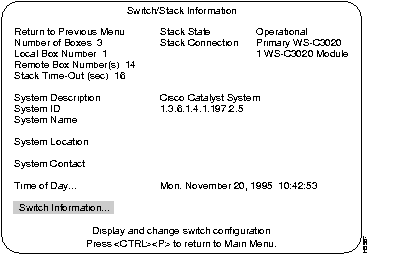
The number of boxes within this Stack.
The box number of the (local) Catalyst 3000 the console is connected to. The local box is also the source of the information displayed in these screens.
The amount of boxes that are in the Stack besides the one displaying this information.
If a box goes off-line, the amount of time the Stack tries to re-establish communications with the box.
Default: 16 seconds
Displays whether the Stack is operational or not.
The type of unit connected to the Stack.
The following headings refer to the information in the local Catalyst 3000 as part of a network system.
Name and model of this unit.
Unique identification code for this Catalyst 3000, assigned at the factory.
Any name you choose to assign to the switch (on a TCP/IP network, it could be the IP hostname.)
Location of the switch.
Person to contact if questions should arise.
An internal clock is used to calculate total time of operation and time of day. To adjust the time, select this item, press RETURN, then enter the month, day, hour, or minute.
The heading "Switch Information..." from the "Switch/Stack" menu is described in the following section.
The following section describes the Switch Information menu.

The MAC address of this unit.
The type of hardware and software and their version levels.
Number of megabytes of dynamic random-access memory in the Catalyst 3000. If a 4MB SIMM is installed, (standard configuration) the user sees "DRAM Installed 4MB." In the standard configuration, (4MB) 6,000 addresses are allowed in each switch. With the 8MB SIMM installed, 10,000 addresses are allowed. The maximum number of addresses allowed is displayed under Main menu: "Statistics," then under "Switch Statistics" as Maximum Number of Stations.
Number of flash memory installed on the Catalyst 3000. If a single flash is installed the number on the screen is 512KB. If two flashes are installed the number on the screen is 1024KB.
"Enabled" indicates that the optional Catalyst 3000 Enhanced feature set is enabled. To enable the feature set, call your local reseller to obtain a 10-digit "key." Highlight the field, enter the key (code), and press RETURN. If you purchased the Catalyst 3000 with the Enhanced feature set and you need to re-enter the code, the code is on the bottom of the unit.
This section describes VLAN, the next selection on the Configuration menu. The optional VLAN feature is available on the Enhanced version of the Catalyst 3000 (contact your Cisco sales representative for information). Using the VLAN feature, you can partition a single Catalyst 3000 into a VLAN each containing its own set of ports. Packets are forwarded only between ports belonging to the same VLAN. The benefit of VLAN is to restrict access from one segment to another, either for security purposes or to reduce intersegment traffic. Figure 7-1 illustrates a Catalyst with four VLANs.

To set up VLANs using the VLAN Configuration menu, specify the ports belonging to the VLANs, then set up the IP configurations, trap configuration (trap receivers are associated with a set of VLANs and a receiver IP address) and spanning tree configurations specific to the appropriate VLANs. If you have already supplied configuration information using the main configuration menus, that information applies to VLAN "default."
The VLAN affects other Catalyst 3000 features in the following ways:
The two headings within this menu are accessible only when the Enhanced Feature Option is installed.
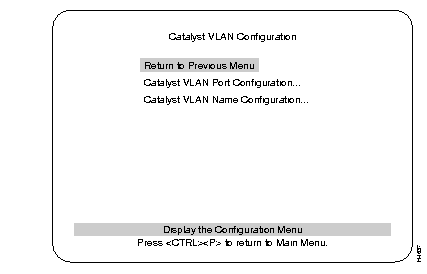
More information on Port and Name Configuration follows these brief explanations.
Displays the VLAN Configuration menu, which you use to assign ports to VLANs.
Displays the assigned name of the VLAN. The names can be changed by using the prompts displayed on that screen.
Use the Catalyst VLAN Port Configuration screen to assign ports to a particular VLAN.
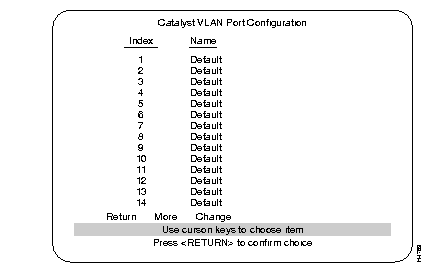
The index number that you want to assign to a VLAN.
The name of the VLAN where you are assigning the ports.
When you select "Change" and press the RETURN key, you are prompted to enter the port number, and select the name of the VLAN.
For each VLAN you set up, you must set up the IP parameters and spanning tree parameters.
Use the VLAN Name Configuration screen to describe each VLAN. The VLAN name can be a maximum of 20 characters in length.
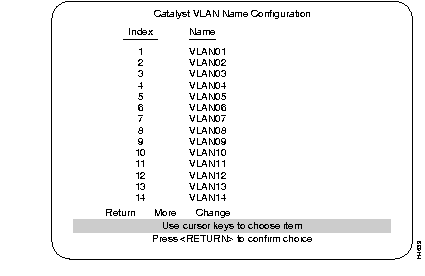
Number of the VLAN index.
Name or description of this VLAN.
Select this menu from the Configuration menu. Use this menu to view or change the IP configuration information.
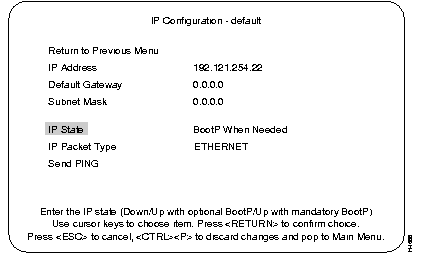
Displays the current IP address. To change it, highlight the selection and press RETURN.
Default: 0.0.0.0
Displays current gateway address. The default is the IP address of the gateway or router through which information must pass to get to the NMS application.
Default: 0.0.0.0
Displays the current subnet mask.
Default: 0.0.0.0
Select choices of IP Disabled, BootP When Needed or BootP Always by highlighting IP State and pressing RETURN, then highlighting one of the choices and pressing RETURN.
Default: BootP when Needed
Display type of Ethernet packet being presented.
Prompts for entering an IP address, then sends a PING to that address.
When a VLAN is IP-disabled, it does not process any IP or ARP packets it receives. This means that no SNMP, Ping, Telnet, or ARP Packets will be responded to when received.
In this state, IP is enabled for the VLAN and will function immediately if a non-zero IP address has been stored in NVRAM when the Catalyst 3000 initializes. In each VLAN that an IP address of 0.0.0.0 and a state of BootP When Needed are stored in NVRAM on boot (or NVRAM is not initialized on boot), the Catalyst will broadcast BootP requests in an attempt to determine its own IP address. Until it receives a reply, this is the only IP function the Catalyst will support (in the VLAN).
BootP When Needed is the factory-set default. A Catalyst for which NVRAM is not initialized (for instance, a new Catalyst out of the box or on a bootup after NVRAM is cleared) or one whose NVRAM is corrupted and unreadable, will therefore always attempt to use BootP the first time.
In this state, IP is enabled for the VLAN but will not function fully on boot until a BootP reply has been received. If a non-zero IP address is stored in NVRAM for a given VLAN in this state when booted, it is cleared to 0.0.0.0 since it would never be used.
When using BootP to determine its IP address, the Catalyst repeats BootP requests at regular intervals, beginning at 1 second each and eventually decreasing to every 5 minutes over time until it receives a valid reply. If the IP display for the VLAN is accessed from the console (or via Telnet from another VLAN) during that time, the Catalyst may cease using BootP if the parameters are set (on display exit) in such a way that BootP would no longer be necessary - for instance, if the IP state is switched from BootP Always to IP-disabled or if a non-zero IP address is specified in any IP state.
Once the Catalyst has ceased sending BootP requests on a VLAN, it does not restart sending requests on that VLAN for any reason besides an entire Catalyst reset. It also does not recognize BootP responses on that VLAN from that point onward.
Besides the IP address, several other parameters in a BootP response are also recognized and recorded in NVRAM, when received in the same response:
One other parameter, the TFTP VLAN, is inferred whenever a TFTP Bootfile name is present in the BootP response. That is, if the Catalyst receives a BootP response that specifies a TFTP Bootfile name, the Catalyst automatically records the VLAN on which the response was received as the TFTP VLAN number. Therefore, the bootfile name should not be specified on a VLAN from which the TFTP server cannot be accessed, either directly or through the VLANs default gateway (if one exists). More information on TFTP is available under the section "TFTP" within this chapter.
The next selection of the Configuration Menu is the SNMP Configuration menu.
Screen displays and explanations of this menu and its sub-menus are presented in Chapter 9, "Monitoring the Network with SNMP."
The next section describes spanning tree and the Spanning Tree menus from the Configuration menu.
The Spanning-Tree Protocol is a bridge-to-bridge link management protocol that provides path redundancy while preventing undesirable loops. To provide path redundancy, the Spanning-Tree Protocol defines a tree that spans all switches and bridges in the extended network; if one of the network segments in the tree becomes inaccessible, the spanning tree reconfigures itself to re-establish the links. To prevent loops, the spanning tree selects just one Catalyst 3000 port as the designated path to the root, assigning it the Forwarding, or active state. It assigns all other ports the Blocking, or standby, state. A port in the Blocking state does not forward any transmitted frames in any direction.
To set up the Catalyst 3000 to use the Spanning-Tree Protocol, you must assign a path cost and path priority to each network segment.
The path cost indicates the relative speed of the segment: The higher the speed of the segment, the lower the path cost. Switches and bridges in the network attempt to determine the path to the route with the lowest path cost. IEEE 802.1D recommends that you assign path costs using the following formula:
Path cost = 1000/LAN speed in Mbps
If two ports to the root have the same path cost, the spanning tree device selects the one with the highest priority (lowest value), an arbitrary value that you assign. To block traffic on a particular segment, assign it low path priority (high value).
The following section describes using Spanning Tree.
Select the Spanning Tree menu from the Configuration menu. Use the Spanning Tree menu to specify whether the Catalyst 3000 is participating in the spanning tree and, if so, to configure spanning tree bridge and port parameters.
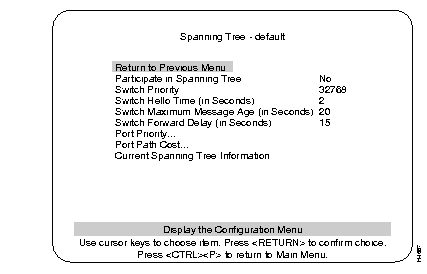
Select Yes or No by moving highlight to heading, pressing RETURN, move highlight to Yes or No and press RETURN. If you select No, the remaining values on the menu will be saved, but will have no effect. Selecting Yes will enable spanning tree upon exiting this screen.
Default: No
Enter a priority value for this Catalyst 3000. The Catalyst 3000 with the lowest priority value in a spanning tree becomes the root. (To change individual port priorities, select Port Priority Menu.)
Range: 0-65535
Default: 32768
Enter a time between configuration messages when this switch is root. The minimum value may not be less than 1. The maximum may not be more than the lower of 10 or Switch Maximum Message Age/2 - 1. The upper range limit that appears reflects the value currently selected for Switch Maximum Message Age.
Default: 2
Enter the maximum message age displayed when this switch is root. The minimum value may not be less than the higher of 6 or (2 x (Switch Hello Time + 1)). The maximum may not be more than the lower of 40 or (2 x (Switch Forward Delay - 1)). The range limits that appear reflect the values currently selected for Switch Hello Time and Switch Forward Delay.
Default: 20
Enter the time the switch waits between transitions from listening to learning, and from learning to forwarding. The minimum may not be less than the larger of 4 or (2 x (Switch Maximum Message Age/2 +1)). The maximum may not be higher than 30. The lower range limit that appears reflects the value currently selected for Switch Maximum Age.
Default: 15
Displays a list of the port priorities of user selectable values (see beginning of this section for a description of the calculation).
Displays a list of port path costs of user selectable values (see beginning of this section for a description of the calculation).
This selection displays more information if spanning tree is set up ("Yes" is selected under "Participate in Spanning Tree" prompt).
When the spanning tree is turned off--that is, you have selected "No" for the "Participate in Spanning Tree" prompt--this menu cannot be selected.
View the Port Priority Menu to set up Spanning Tree priorities for each port.
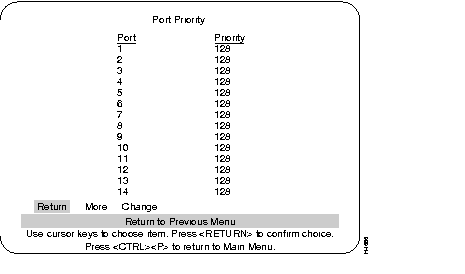
The number of the port.
Select the port whose priority value you want to change, highlight "Change" and then press the RETURN key, enter the port number, then enter the new value. The port with the lowest number has the highest priority. New values take effect when you return to the previous menu.
Range: 0-255.
Default: 128
To view more ports in the table.
To change or add values to specific ports.
Use the Port Path Cost Menu to view and change the spanning tree path cost associated with each port. The Spanning Tree uses port path costs to determine which port to select as a forwarding port.
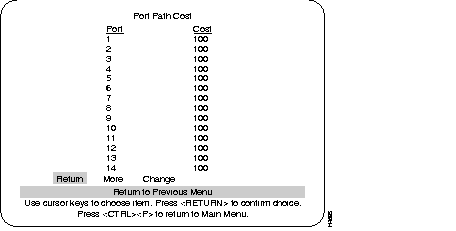
Select the port whose cost you want to change, press RETURN.
After selecting the port, enter a new value. When the spanning tree reconfigures itself, it selects forwarding ports based on the port cost. Therefore, assign lower numbers to ports attached to faster media (such as Full-Duplex Ethernet, Fast Ethernet or EtherChannel), and higher numbers to ports attached to lower-bandwidth media, such as Half-Duplex Ethernet. New values take effect when exiting this screen by choosing Return to Previous Menu.
Range: 0-65535.
Default: 100
To change or add values to specific ports.
Use the Current Spanning Tree Information screen to view a summary of all spanning tree information for each port; the information is updated every second. You cannot change any information on this screen. When the spanning tree is turned off--that is, you have selected "No" for the "Participate in Spanning Tree" prompt--this menu cannot be selected.
When the Catalyst 3000 is configured with EtherChannels, spanning tree packets use the primary port of the EtherChannel.
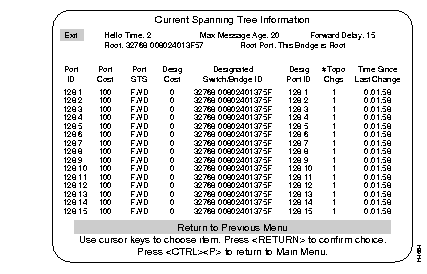
The Hello Time, in seconds, advertised by the root and used by all bridges and switches in the active topology of the spanning tree network.
The Maximum Message Age, in seconds, advertised by the root and used by all bridges and switches in the spanning tree network.
The Forward Delay Time, in seconds, advertised by the root and used by all bridges and switches in the spanning tree network.
The priority and MAC address of the switch in the spanning tree that this switch has accepted as the root device.
The number of the port on this switch that is closest to the root. This switch communicates with the root through this port. If this switch is the root, "This Bridge is Root" is displayed.
The port ID, used to determine the role of the port in the spanning tree. The port ID is expressed in the form <port priority>.<port number>. All ports in an EtherChannel have the same ID number.
The Port Path Cost for each port on the switch. The Port Path Cost helps determine the role of the port in the spanning tree network.
Current state of this port within the spanning tree: DSB (disabled), BLK (blocked),
LSN (listening), LRN (learning), or FWD (forwarding). The rules that define the state of the port are as follows:
The cost for a packet to travel from this port to the root in the current spanning tree configuration. The slower the media, the higher the cost.
Priority and MAC address of the device through which this port has determined it must communicate with the root of the spanning tree.
Port on the designated device through which this switch will communicate with the root of the spanning tree. This information is useful if the Catalyst 3000 is the designated switch on one or more network segments.
Number of topology changes, which is the number of times the port has entered the Forwarding state plus the number of times the port has made the transition from Forwarding to Blocking. The counter is reset when the switch is reset or the spanning tree is turned on: whichever is most recent.
The time since the last time the port entered the Forwarding state or made the transition from Forwarding to Blocking.
You can enable or disable a port using the Port Configuration Menu. The menu also reports other port settings.

The port number.
Type of interface associated with this port
Whether a valid link status signal is associated with the port. "Up" means a device is connected to the port, "down" means that no device is connected, and "unknown" refers to 10Base-T port 1. Port 1 is not recommended for this use. See Chapter 5, "Installation" for an explanation on the use of port 1.
The MDI setting for 10Base-T ports.
The Ethernet speed for that port.
Shows error handling mode, such as Cut-Through or Store and Forward.
For 10Base-T ports; shows the current setting of the Duplex DIP switch for this port, which is located on the back panel. New duplex settings take effect when the DIP switch is moved.
Operational status of ports. Toggle between enabled and disabled by selecting the port and pressing RETURN. The new status takes effect immediately.
Default: Enabled
This menu provides information on any expansion modules that were installed. The Catalyst 3000 is listed as the first module.
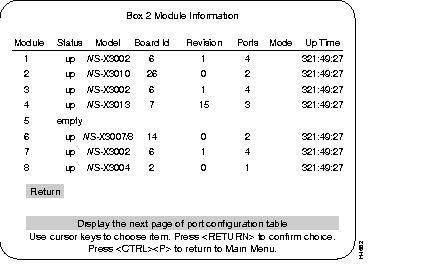
Lists if the module slot is populated and if so, if it is enabled (up/down).
Lists the type of module.
Lists the revision level of the module.
Lists how many ports are on the module.
Lists how long the module has been active.
The screen displays and explanations of this menu and its sub-menus are presented in Chapter 10, "Monitoring Port Activity with SwitchProbe."
The following section is a description of EtherChannel and how it is used with the Catalyst 3000.
To improve interswitch bandwidth, you can create an EtherChannel by connecting two Cisco Catalyst 3000 devices that have two to seven links. An EtherChannel provides bandwidth of from 20-80 Mbps in Half-Duplex mode, or from 40-160 Mbps in Full-Duplex mode. You can create an EtherChannel only between two Catalyst 3000 devices or between a Catalyst 3000 and a CiscoPro unit, and not between a Catalyst 3000 and a workstation.

The EtherChannel feature affects other Catalyst 3000 features in the following ways:
EtherChannel software learns addresses differently than regular ports, as follows:
Use the EtherChannel menu to add, delete, and change EtherChannels.

Use the EtherChannel Configuration menu to add, delete, and change EtherChannels. A description of creating an EtherChannel follows.
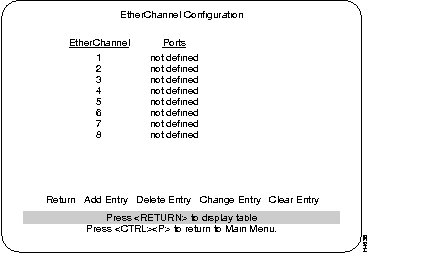
List of different EtherChannel set ups.
The ports within that specific EtherChannel.
Prompts you to enter port numbers in the EtherChannel. Enter at least 2 ports, but no more than 7 ports, from lowest number to highest, separated by spaces. Don't use 10Base-T port 1 for EtherChannel.
Asks whether you want to remove the entry, then deletes the selected EtherChannel.
Prompts you to re-enter the port numbers in the selected EtherChannel, from lowest to highest, separated by spaces.
Deletes all EtherChannels.
Follow these steps to set up an EtherChannel:
Step 1 Disconnect the ports you want to add to the EtherChannel, or disable them using the Port Configuration menu.
Step 2 For one Catalyst, select the EtherChannel menu (shown later in this section), then choose Add Entry from the menu bar at the bottom on the screen.
Step 3 Enter the ports (port 1 is not recommended for EtherChannel use) for the EtherChannel column, separated by spaces.
Step 4 Choose Exit.
Step 5 Repeat steps 1-4 for the other Catalyst devices.
Step 6 Set the Address Aging Time to the same value for the Catalyst devices.
Step 7 If you disconnected the ports in the EtherChannel, reconnect them. If you disabled them using the Port Configuration menu, use the menu to re-enable them.
Use the Running EtherChannel Configuration menu to display the status of the EtherChannel.
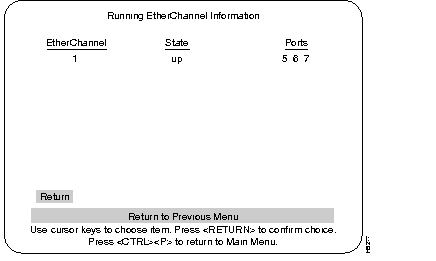
The number of the EtherChannel referring to the information displayed on the present screen.
Whether the specified EtherChannel is active or not.
What ports are in that EtherChannel.
The Address Filtering feature enables you to restrict certain users from communicating with other users. To do this, you can specify source and destination MAC-layer Ethernet addresses to be filtered at the source port. Ethernet addresses can be unicast, multicast, or broadcast.
The advantage of address filtering is increased access control and network segmentation. For example, suppose one port is connected to a server containing confidential information from the engineering workgroup. You can prevent access to the server by setting up filters for the addresses of connections from workgroups other than engineering. This is an example of two "types" of filters, "allowing a source address" (engineering) or "blocking a source address(es)" (other workgroups). Examples of different types of filters are allowing, forcing, or blocking packets from a source address, or allowing, forcing, or blocking packets to a destination address. A detailed explanation of filter types is in the section Configure Filters Screen from the MAC Filter and Port Security Menu
Observe the following guidelines when setting up address filters:
The following menus, in this Address Filtering section, are used to set up address filtering. More explanations of address filtering are presented as functions within these menus are described.
The MAC Filter and Port Security Screen:
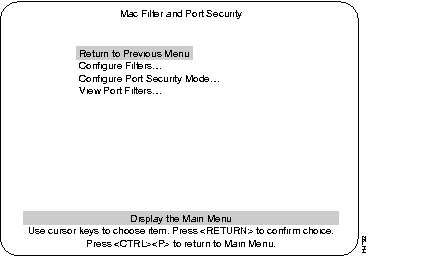
Used to establish specific filtering of addresses.
Establishes address security at specific ports.
Displays filtering set up for specific ports.
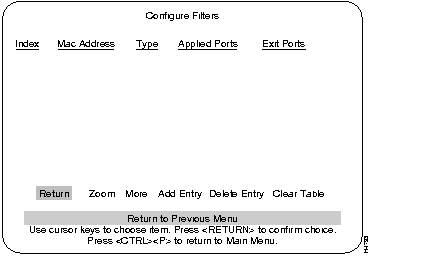
When the Add Entry is selected, a list is displayed of the available filter functions with a selectable highlight. After the user makes a choice, the program then prompts for the necessary parameters.
There are four filter functions from which to choose. They are:
The following is a description of the above filter functions:
The purpose of this filter is to restrict a certain address, on filtered port(s), from sending any packets. If you select this filter, the following parameter fields appear for you to enter data:
Please enter the MAC address (xx xx xx xx xx xx)
Please enter the port(s) to apply this filter:
The purpose of this filter is to restrict a certain address, on filtered port(s), from receiving any packets. If you select this filter, the following parameter fields appear for you to enter data:
Please enter the MAC address (xx xx xx xx xx xx)
Please enter the port(s) to apply this filter:
The purpose of this filter is to restrict a certain address, on filtered port(s), so it can send packets only to specific ports. If you select this filter, the following parameter fields appear for you to enter data:
Please enter the MAC address (xx xx xx xx xx xx)
Please enter the port(s) where a matching packet is allowed to go:
Please enter the port(s) to apply this filter:
The purpose of this filter is to constrain a certain address, on filtered port(s), so any packets sent to it are forced to specific ports. If you select this filter, the following parameter fields appear for you to enter data:
Please enter the MAC address (xx xx xx xx xx xx)
Please enter the port(s) where a matching packet must go:
Please enter the port(s) to apply this filter:
For a stack configuration you cannot enter more than one port on any remote box. You can enter more than one port on the local box.
The information in each column of the Configure Filters menu is described as follows:
The address the filter is applied to.
It is determined by the filter function selected. The type of functions are:
The port(s) where this filter entry is applied for that specified MAC address.
The specified port(s) where a packet is allowed to go, or forced to go (for that specific MAC address).
The type of filter functions that would not have an exit port are:
The type of filter functions that would have an exit port are:
This mode establishes secure address levels for specific ports.
Selecting this heading at the MAC Filter and Port Security screen, presents a screen with the Configure Port Security table on it, as shown below.
There are four address security choices:
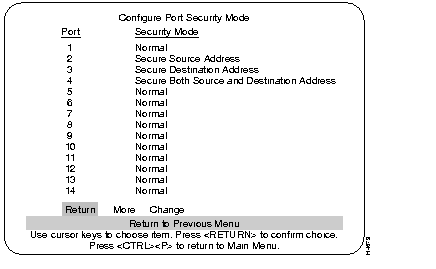
The following screens are examples of ports using the MAC address filters and port security.

Numerical order of entries.
Filter Address
List of descriptions of security modes as assigned at Configure Port Security Mode menu:
Return to main menu.
Displays additional entries in the filter table if the table contains multiple pages.
The type of security mode applied to this port.
You can set the per-port aging value using the Address Aging menu. The following describes the types of address aging.
There are two types of aging:
There are two levels to set for the port and master aging tables:
Time Interval Aging is a time limit, in minutes, which will drop "older" addresses after the selected time.
Automatic On-Demand Aging stores addresses until reaching maximum capacity of the table, then deletes addresses, (in the following specific order) down to a selected percentage level and continues to cycle in the same manner.
More information on address aging and the address aging screens is presented in the following sections.
Address aging is accessed through the Address Aging heading from the Configuration Menu.

Highlighting this selection and pressing RETURN will display the Port Address Table Aging menu. Use this menu is to set each port on the Catalyst 3000 to the aging time, in minutes, and to the demand aging level percentage you want.
This screen shows the Master Aging Time and Demand Aging Level. An example of that selection is shown after the Port Address Table Aging screen.
The following displays a view of the Port and Master Address Table Aging screens and describes the information within them.
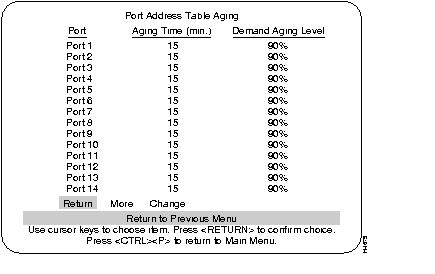
The port to which you want to assign an aging time.
A valid port aging time associated with the port. Addresses will be discarded after reaching the set time limit. The default setting for this parameter is 15 minutes. The maximum time for this value is 9999 minutes.
Sets a percentage threshold of address table capacity to ensure that the port's address table is populated only by the most frequently used addresses. Addresses are stored until reaching the maximum capacity of the table, then discarded in a specific order until the set percentage of table capacity is reached and then cycles in the same manner.
The Master Address Table Aging is the aging value of a set time, in minutes, and a set percentage level after which unused addresses are removed from its table. Addresses that are local to a port but did not fit in its address table ("orphans") will be removed from the master and all port address tables after the master aging time, regardless of whether the address has been seen within that time period. This is to ensure that no unused address will remain in memory for an indefinite time.
Master Address Table Aging screen:
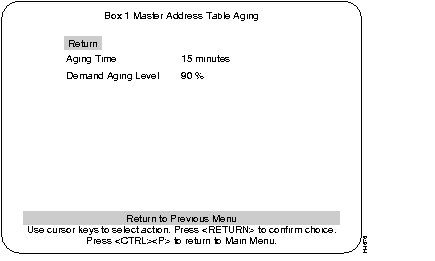
The Master Address Table Aging screen contains two main headings:
The box (Catalyst 3000) that this Master Address Table Aging screen is in reference to.
This value is set by selecting the heading, pressing RETURN and entering a number, in minutes, from 0 to 9999. Addresses will be discarded after reaching the set time limit. Using the setting value of 0 turns aging off.
This parameter works in the same way as Port Demand Aging Level, only using the system address table.
This screen shows the status of the switching error-handling modes available on the Catalyst 3000.
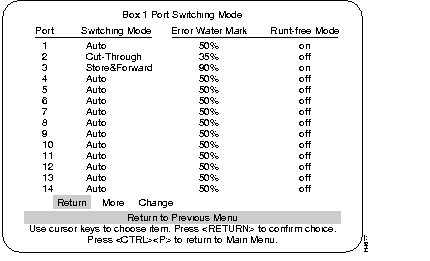
Displays three modes of error-handling switching:
To change the mode, highlight "Change" and press RETURN. You are prompted to select mode, then the high water percentage (if Auto mode selected) and finally the setting for Runt-free mode.
If Auto mode is selected for that port, set at what percentage level of errors the Catalyst 3000 will switch from cut-through to store-and-forward mode. Percentage level is set by the user.
The last item this screen displays is the setting and displaying of the Runt-free mode. This mode is set to either on or off; on means that an incomplete packet (less than 64 bytes) will be discarded, and a runt packet error is logged and displayed under the Statistics menus; off means runt packets will be forwarded.
As the name implies, this feature is to suppress broadcast packets. This function is set on a per port basis at the Broadcast Suppression screen. If set to on (enable), that port is set to a percentage threshold level (Broadcast Water Mark) at which broadcast packets are suppressed (percentage is based on total traffic). If the broadcast level on a specific port exceeds the set threshold, all broadcasts originating from that port are blocked until the broadcast level drops below that mark.
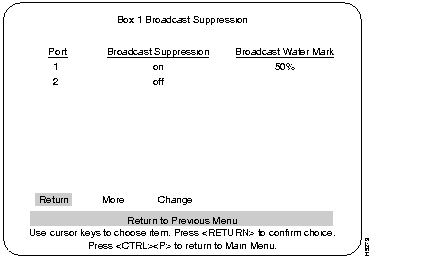
Displays whether broadcast suppression is enabled or disabled for that specific port.
A user defined percentage level based on broadcast traffic compared to the total traffic on that port. If broadcast traffic exceeds this level, packets are suppressed until they fall below that level.
Use the Password menu to add, change, or delete a password. If you establish a password, users must enter it to access the Console menus. If there is no password, just press RETURN at the password prompt.
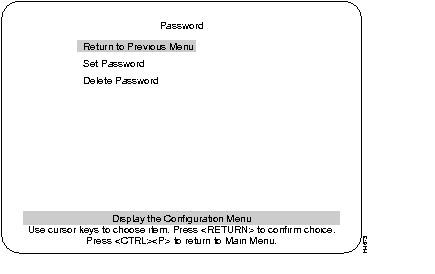
Establishes or changes the password.
Deletes the password.
The system prompts you to enter the present password before it allows you to change or delete the password. If you are establishing a new password, press RETURN at the Set Password prompt.
The password is saved across warm boots and power cycles.
The following procedure describes how to establish a console or Telnet session.
This menu has the selections for configuring console and Telnet sessions.
There are three selections in the Console Configuration menu:
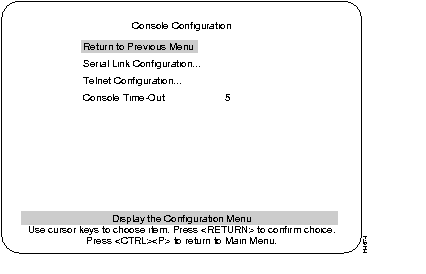
An example of that screen and an explanation of its contents follows.
An example of that screen and an explanation of its contents follows.
A value that can be set to determine when the console session will timeout and return to the Greeting menu. If the value is set to zero, the console will never time out.
Use the Serial Link Configuration Menu to configure the Catalyst 3000 to communicate with the console via modem. The default baud is 9600.
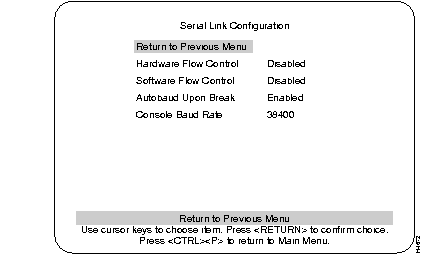
To set up a modem, as part of the Serial Link Configuration, follow these steps:
Step 1 Set Wait for a Connection to 45 sec.
Step 2 Set Pause Between Calls to 6 sec.
Step 3 Set Autobaud Detect to On.
Step 4 Set the Drop DTR (Data Terminal Ready) to Yes.
Step 5 Set the Send CR Between Calls to Yes.
Step 6 Set Send init if CD High to Yes
Enables or disables RTS/CTS handshaking.
Default: Disabled
 | Caution Hardware handshaking must be turned on at both the terminal and the Catalyst 3000 and you must have a 7-wire or a 9-wire cable to the terminal. If hardware handshaking is off and you are using a 3-wire cable, a catrostraphic failure of the Catalyst 3000 could occur. |
Enables the XON and XOFF characters, which are 11 and 13 hex, respectively.
Default: Disabled
Enables the Autobaud feature. When a BREAK key is sent or received the baud rate is reset when you press the RETURN key rapidly for five seconds. It is recommended that this feature is not disabled.
Default: Enabled
Default: 9600
Start the console by pressing RETURN after re-booting the system. If a Telnet session is active, press RETURN at the console to terminate the Telnet session and press RETURN again to start the console session.
Pressing Cntrl-P returns the console session to the Main Menu and pressing Cntrl-B returns to the Greeting Menu.
A Telnet session can be terminated abnormally in a UNIX environment, especially by being killed by another process. If the user environment seems to have locked after termination of the Telnet session, try typing <CTRL><J>stty sane<CTRL><J>. Because the Telnet Server is doing the echoing for the user, the user's terminal capabilities have been modified for the duration of the Telnet Session due to the Telnet option negotiation. If the user's Telnet process or task is abruptly terminated, the user's terminal may be left in a no-echo, raw mode.
The following menu and functions describe Telnet configurations.
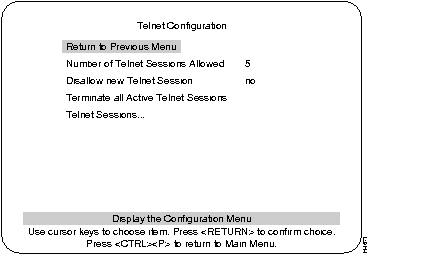
Returns to Console Configuration menu.
Limits the number of Telnet sessions. Numbers allowed are from 1 to 5. Highlight this selection and press RETURN and enter the number.
Choice of Yes or No to allow or disallow a new Telnet session. Press RETURN at this selection and use arrow keys to highlight Yes or No and press RETURN.
If this selection is highlighted and RETURN is pressed any Telnet sessions will be terminated.
Shows status of "Remote" and "Local" Telnet sessions.
Screen of Telnet Session:
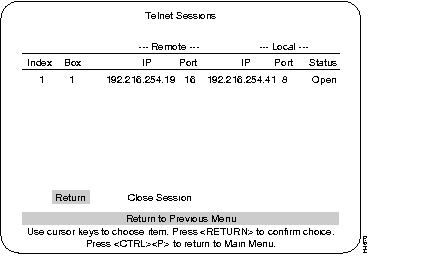
Numerical order of entries.
The number ID of the Catalyst 3000 in a stack.
Lists the IP address and the port number of the Remote Telnet session.
Lists the IP address and the port number of the Local Telnet session.
The observe the following when starting a Telnet session to the Catalyst 3000.
The Telnet session can be terminated by pressing Cntrl-B or any other means available through the user's Telnet application.
The following can terminate a Telnet session:
The Download menu is accessed from the Main Menu.
Downloading is used to load the Flash Memory within the Catalyst 3000. The Download menu displays two download choices. The two choices are TFTP (Trivial File Transfer Protocol) download and the Serial Link download (console).
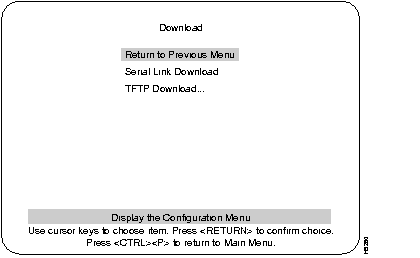
Serial Link download is for downloading via the console. Selecting the Serial Link download displays a prompt requesting to "confirm new code download via serial port (Y or N)". Selecting Yes starts the Serial Link downloading. Follow the prompts as they are displayed.
The next section describes TFTP, and the TFTP downloading.
TFTP is not invoked automatically on the Catalyst 3000 as it is on certain other network devices such as a diskless workstation. This is because there should normally be a functional software image in Flash memory and, therefore, TFTP is not a standard part of the Catalyst 3000 bootup procedure (under normal circumstances). TFTP is intended for use during software upgrades and, once a new image is installed, there should be no need for TFTP until the next software upgrade is installed.
In view of this, the TFTP function in the Catalyst 3000 is designed as an explicitly requested operation with operator-settable parameters. Note that changes to these parameters may be altered and are used when starting a download in the display, however they are not recorded until the display is exited normally.
The TFTP Download menu is accessed through the Main Menu. From the Main Menu select the Download Menu and then select the TFTP Download Menu.

The address of the host serving as the TFTP server.
The VLAN name through which the download is attempted.
The file the Catalyst 3000 attempts to download, as it is to be received and interpreted by the TFTP server. (The security mode in use on the TFTP server may affect this.)
The function "Execute Network Download" initiates the download. The screen displays which block it last received from the server (Block 0 if no reply has been received) until the last packet arrives. The Catalyst 3000 does not attempt to load any of the image into FLASH memory until it receives the final packet. Therefore, if interrupted or cancelled for any reason before the last packet, the previous system image remains intact in FLASH memory.
Once the last packet has arrived, the Catalyst 3000 immediately begins clearing FLASH memory and then loading it with the new image.
The Catalyst 3000 continues to use its previously loaded software until its next reset by whatever means, then the newly stored image becomes functional.
Use this function for a Stack configuration. This function initiates downloading for the Stack. The procedure is similar to the above single stand-alone Catalyst 3000 download; however, the Stack download procedure downloads to the entire Stack of switches in one operation. (Downloading is done one switch at a time, until all of the switches are completed.)
When the Stack download procedure is used, only the same code or the same level of code can be downloaded for all of the switches in the Stack.
The Reset menu is accessed from the Main Menu.
The Reset screen, as shown below, displays the reset options available with the Catalyst 3000.

Number of times the switch has been reset since the switch was powered on or ran power-on diagnostics. This is an informational heading, the data cannot be changed.
This number is not reset to 0 when Non-volatile RAM is cleared.
The following four headings within the Reset menu are command functions that can be selected and initiated by moving the highlight over the heading and pressing RETURN.
A reset function is initiated with this selection. It resets the switch hardware; runs diagnostic tests; clears all counters, including address tables; and restarts the Catalyst 3000. When the Catalyst 3000 reboots, administrative parameters from nonvolatile memory are used to initialize the operational parameters. This takes approximately 4 to 5 minutes.
This command resets the switch hardware; clears all counters, including address tables; and starts the Catalyst 3000. When the Catalyst 3000 reboots, administrative parameters from nonvolatile memory are used to initialize the operational parameters. This takes approximately 40 seconds.
Selecting this command clears all address table entries for a specified port (user is queried for which port to reset), sets port traffic counters to zero, and sets Time Since Last Reset for this port to zero.
Deletes all user-configured parameters; baud rate, IP address information, EtherChannel, VLAN, Spanning Tree and then resets the switch.
This is a selectable option that determines whether diagnostics are, or are not, initiated during power-on. To change the selection, highlight the heading and press RETURN, then select Enabled or Disabled, and press RETURN.
Default: Enabled
|
|